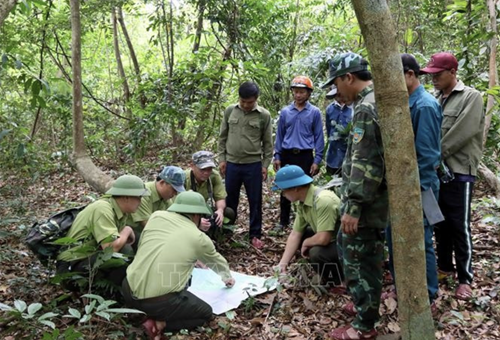Changing mindsets
For years, Tran Quoc Hen’s family, residing in Cu Lac 2 village in Phong Nha commune, has relied on the forests of the Phong Nha – Ke Bang National Park for their livelihood by participating in forest protection contracts. Support from forestry development funds and carbon credit sources has helped improve his family’s income and raise public awareness of their responsibility in forest preservation.
    |
 |
|
Patrol teams determine directions and mark the places they have visited in the Nha - Ke Bang National Park. |
Hen said that in the past, when life was tough and forest protection awareness was low, locals relied on timber from the forest to build their homes. But in recent years, thanks to awareness campaigns and forest protection contracts, communities have gained a stronger understanding of the value of forests and have taken greater responsibility in preserving them and protecting Phong Nha – Ke Bang National Park.
Hoang Ha, a resident of Phong Nha commune, said that over 300 households in 35 villages located in the buffer and core zones adjacent to the park are currently contracted to care for and protect the forest.
In addition to safeguarding the heritage, locals also act as “ambassadors,” promoting its image through services like tourist transport, photography, and souvenir sales. Their efforts help domestic and international visitors better understand the park’s core values and vast tourism potential.
Nguyen Thi Tinh, a boatwoman at the Phong Nha – Ke Bang Tourism Centre, said, “Since the park was recognized as a World Natural Heritage site, we switched to working as boat guides, serving tourists on the Son River.”
"This job not only provides a stable income by serving both domestic and international visitors, but also offers an opportunity to promote the tourism and ecological values of this heritage."
Joint effort in conservation
Covering 123,326 hectares, the park is located in the middle of the Annamite Mountain Range in Quang Binh province, and shares its boundary with the Hin Namno Nature Reserve in Laos to the west. It is divided into three zones - a strictly protected zone (100,296 ha), an ecological restoration zone (19,619 ha), and an administrative-service zone (3,411 ha).
Often described as a vast geological museum, the park features 447 caves with a total length of 246 kilometers. Its vegetation includes 15 major habitat types and 21 important vegetation formations. Evergreen forests cover 93.5% of the area, with over 90% consisting of tropical rainforest ecosystems on limestone mountains - the largest of its kind in Southeast Asia and largely untouched by human activity.
Dinh Huy Tri, Deputy Director of the Management Board of the Phong Nha – Ke Bang National Park, stated that the community plays a role as a key stakeholder in the process of preserving and promoting heritage values.
According to Tri, in recent years, the local community has been actively involved in forest protection. Local authorities have also organized communication campaigns to raise public awareness of forest conservation, environmental protection, biodiversity preservation, and wildfire prevention. They have also worked to improve policy mechanisms and mobilize support from programs and projects to promote sustainable forest management while creating income and livelihoods for residents.
He affirmed that the local authorities and community have come to realize that participating in heritage preservation brings direct benefits and income to residents. As a result, locals have actively engaged in protecting the heritage, earning recognition and appreciation from international organizations.
From their precarious life dependent on illegal logging and forest exploitation, households living around the Phong Nha – Ke Bang National Park have now given up deforestation. Instead, they grow and protect the forest and engage in tourism services. They are now both guardians and beneficiaries of the natural heritage.
Source: VNA